by Lacey Cooke | Jun 16, 2019 | 01 What's New, Records & databases
Featured this week are new and updated records for South Africa. The all-free site FamilySearch has two new and one updated collection for South Africa including death and probate records and passenger lists. Ancestry.com also has an updated collection of church records going back to the 17th century. Also new at Ancestry.com are four genealogy records collections for Essex, England.
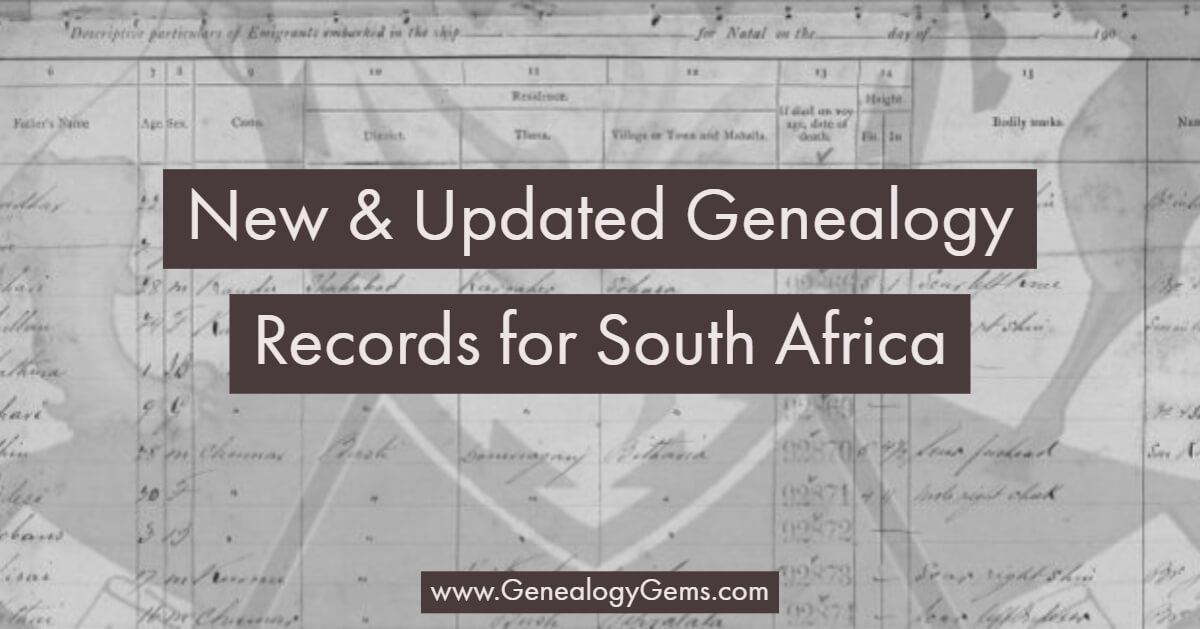
Featured: South Africa Genealogy Records
If you have ancestors that lived in South Africa, you may already be familiar with some of the challenges of researching them. And if you’re new to genealogy or to your ancestors that lived in South Africa, you might be in for a surprise when it comes to records: census records aren’t available! They are routinely destroyed after being abstracted and thus not available to the public.
So where’s the best place to start looking? Most genealogy experts will tell you to start with death notices. A death notice is different than a death certificate, in that it’s not an official document. Rather, it is a document provided by next of kin, friends, or associates of the deceased. Information provided may not be 100% accurate or reliable, but it can often provide really helpful details and a glimpse into the person’s life.
FamilySearch as a new collection of South Africa, Orange Free State, Probate Records from the Master of the Supreme Court, 1832-1989. There are over 300,000 records in this set, and the most useful records in the collection are the death notices, which give detailed information. The probate records usually have multiple pages and are included in a probate file, which is identified by a probate number.
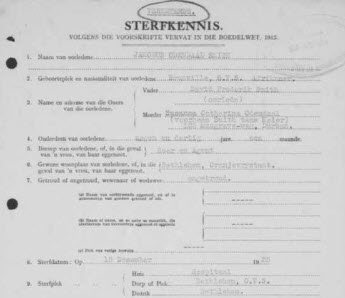
When a person died, the nearest relative or other connection should have completed a death notice and sent it to the Master of the High Court within 14 days of the death. These records might tell you the deceased’s name, birthdate and place, marriage status, parents’ names, the names of their children, information about property and wills left, and more.
There is an updated collection of actual death certificates at FamilySearch, which is the
Transvaal, Civil Death, 1869-1954 collection. “Death certificates are arranged chronologically and alphabetically by place and include full name, parent’s name if under the age of ten, mother’s residence, age, sex, birthplace, marital status, occupation, whether pensioner or pensioner’s dependent, place and date of death, residence, place of burial, cause and duration of death, and background of informant. For the years 1899-1902, records are arranged separately by internment camp and district where death occurred.”
If you’re an Ancestry.com subscriber, you can also check out the recently updated collection of
Dutch Reformed Church Registers, 1660-1970. This collection contains records from various locations which were part of historic Cape Colony, including Namibia, Cape of Good Hope province and Transvaal province. Record coverage will vary depending on location. It is also available at
FamilySearch.
Essex, England
Ancestry.com has four new collections of genealogy records for Essex, England. These BMD records date back as far as the 16th century and may hold important details about the lives of your ancestors living in Essex.
Church of England Births and Baptisms, 1813-1918: “Children were usually baptised within a few days or weeks of birth. The records generally include when the baptism took place and in what parish, child’s Christian name, parents’ given names and the family surname, residence, father’s occupation, and who performed the ceremony. Sometimes you’ll find additional details such as date of birth. Early records may contain less detail.”
Church of England Marriages, 1754-1935: “Couples were usually married in the bride’s parish. Marriage records typically include the bride and groom’s names, residence, date and location of the marriage, names of witnesses, condition (bachelor, spinster, widow, or widower) and the name of the officiant. Some records may also include the father’s name and occupation.”
Church of England Deaths and Burials, 1813-1994: “Burials took place within a few days of death. Records generally list the name of the deceased, residence, burial date, and age at death.”
Church of England Baptisms, Marriages and Burials, 1538-1812: “This collection contains images of Church of England parish registers of baptisms and burials during the years 1538–1812, and marriages during the years 1538-1754 from Essex, England.”
Get more new and updated records every week!
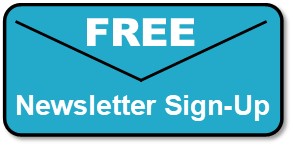 Each week we round up the new and updated genealogy records collections for you in a helpful article so you can jump right into researching! Our free weekly email newsletter always has the latest records round up article, as well as other featured articles on genealogy methodology, inspiration, tips and tricks, and more. Plus the newsletter also lets you know where there is a new episode of The Genealogy Gems Podcast, new videos, and updates on news and events. And best of all it’s free! Sign up today to get our email newsletter once a week in your inbox.
Each week we round up the new and updated genealogy records collections for you in a helpful article so you can jump right into researching! Our free weekly email newsletter always has the latest records round up article, as well as other featured articles on genealogy methodology, inspiration, tips and tricks, and more. Plus the newsletter also lets you know where there is a new episode of The Genealogy Gems Podcast, new videos, and updates on news and events. And best of all it’s free! Sign up today to get our email newsletter once a week in your inbox.

About the Author: Lisa Louise Cooke is the producer and host of the Genealogy Gems Podcast, an online genealogy audio show and app. She is the author of the books The Genealogist’s Google Toolbox, Mobile Genealogy, How to Find Your Family History in Newspapers, and the Google Earth for Genealogy video series. She is an international keynote speaker and the Vice President of the Genealogical Speakers Guild.
Disclosure: This article contains affiliate links and Genealogy Gems will be compensated if you make a purchase after clicking on these links (at no additional cost to you). Thank you for supporting Genealogy Gems
by Lisa Cooke | Jul 13, 2016 | 01 What's New, FamilySearch, MyHeritage
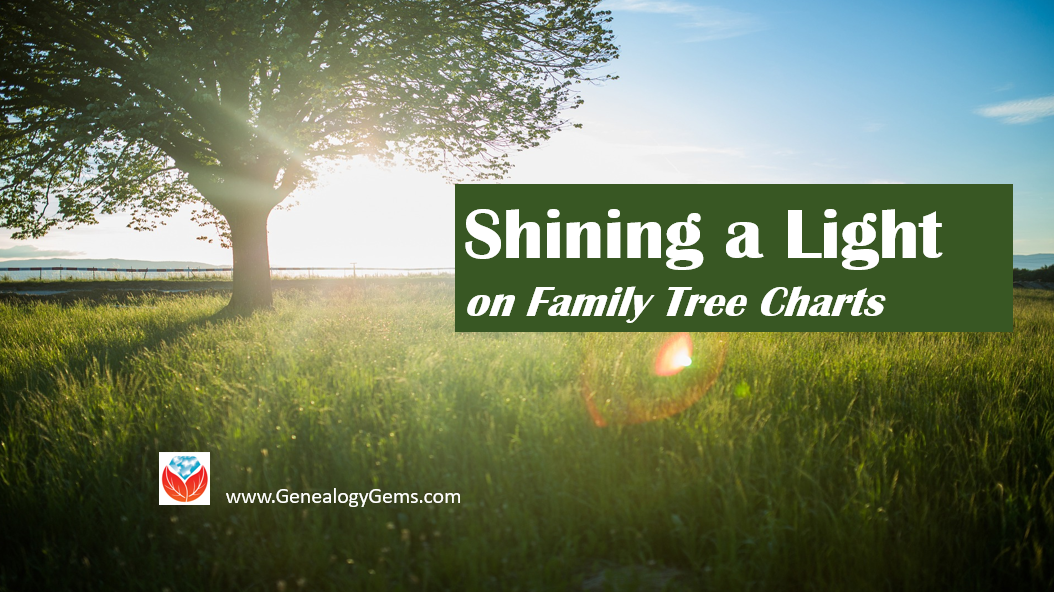
Family tree charts come in all shapes and sizes. Fan charts, bowtie charts, and the popular portrait charts are just a few of the many options. Many of our favorite genealogy software and apps allow us to create a printed version of our family tree. Creating and printing a beautiful family tree chart can bring a little sunshine into your own family tree!
Free Family Tree Charts at FamilySearch
FamilySearch Family Tree is free and available to everyone. When you have created your free account and add your family tree data, you are given four family tree viewing options. These options include the landscape, the fan, the portrait, and the descendancy views. Each of these viewing options are available to download or print in chart form.
I really like the portrait chart. If you have many pictures of your ancestors, I think you will love this option. To see the portrait view, click on the second icon at the top left of the family tree screen.
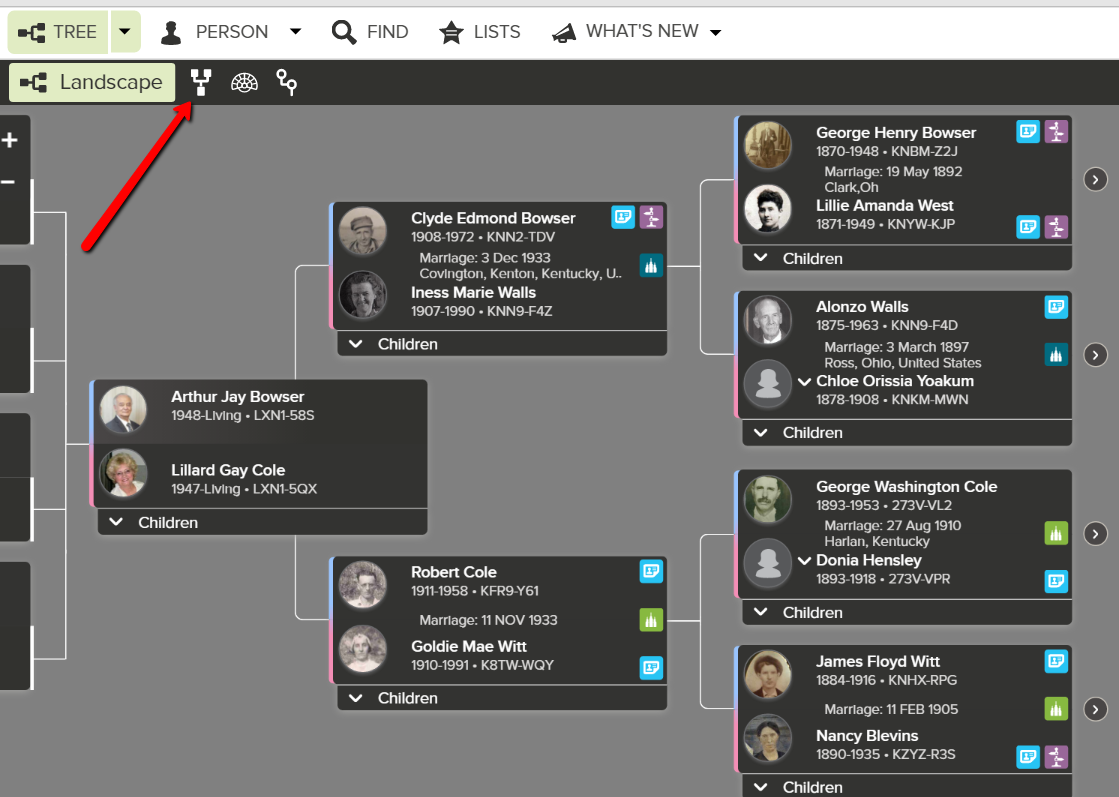
Landscape view of family tree at FamilySearch
At the new screen, you will see the look of your family tree has changed. This is the portrait view. If you would like to print or download the chart, simply click the print icon at the right of the screen. This will open a default screen where you have the option to rotate, print, and download the chart.
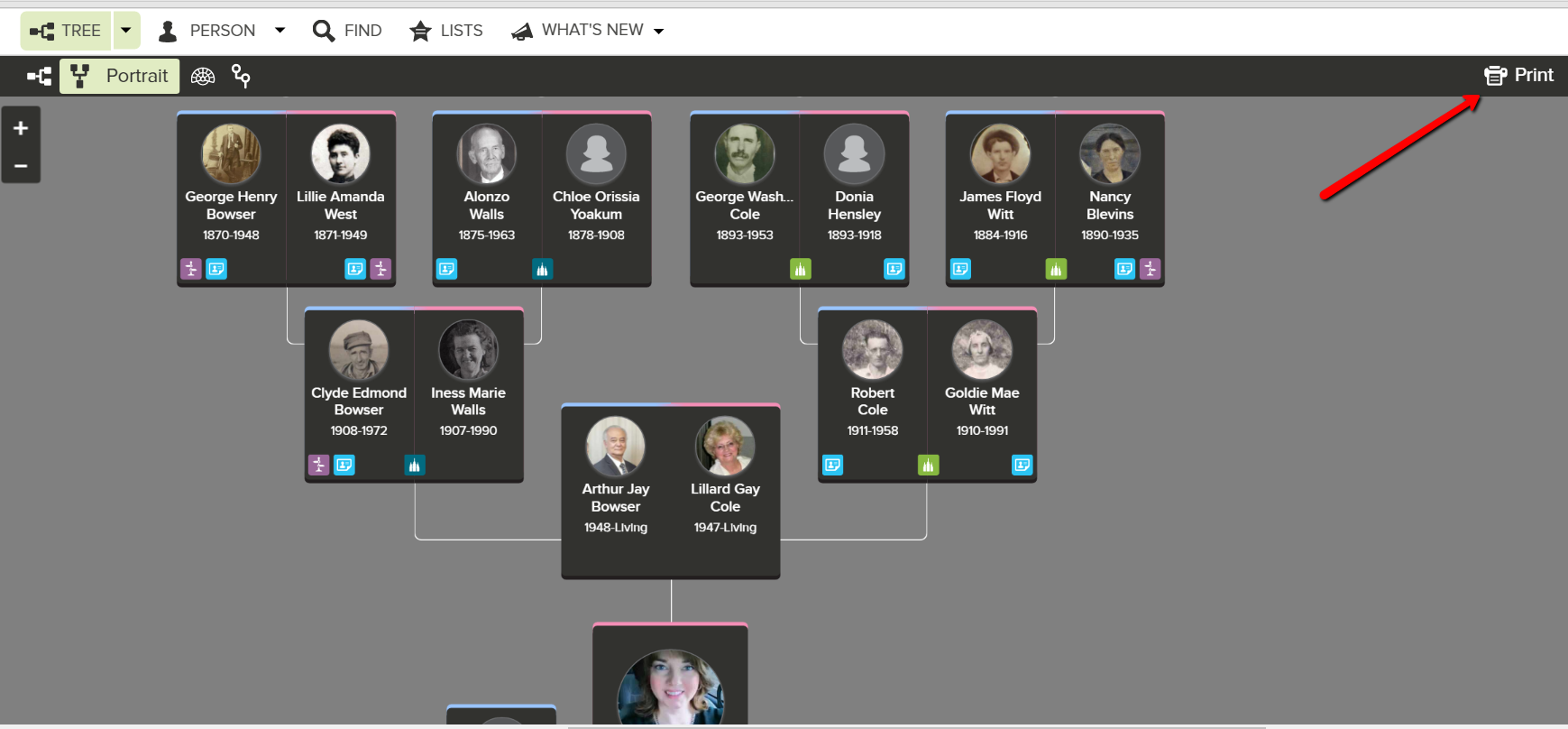
Portrait view of family tree at FamilySearch
Some of my friends have downloaded their charts to a thumb drive and then taken them to Staples or Office Depot to print them in poster size. Isn’t that neat? What a great way to share the family history at your next family reunion!
Family Tree Charts at MyHeritage
MyHeritage has always had a nice assortment of family tree chart options. One of my favorites is the “bowtie chart.” This bowtie chart shows the main person in the center next to their spouse. Ancestors are on either side, and their children are below. With eighteen style options, you can be sure to find one that is perfect for you.
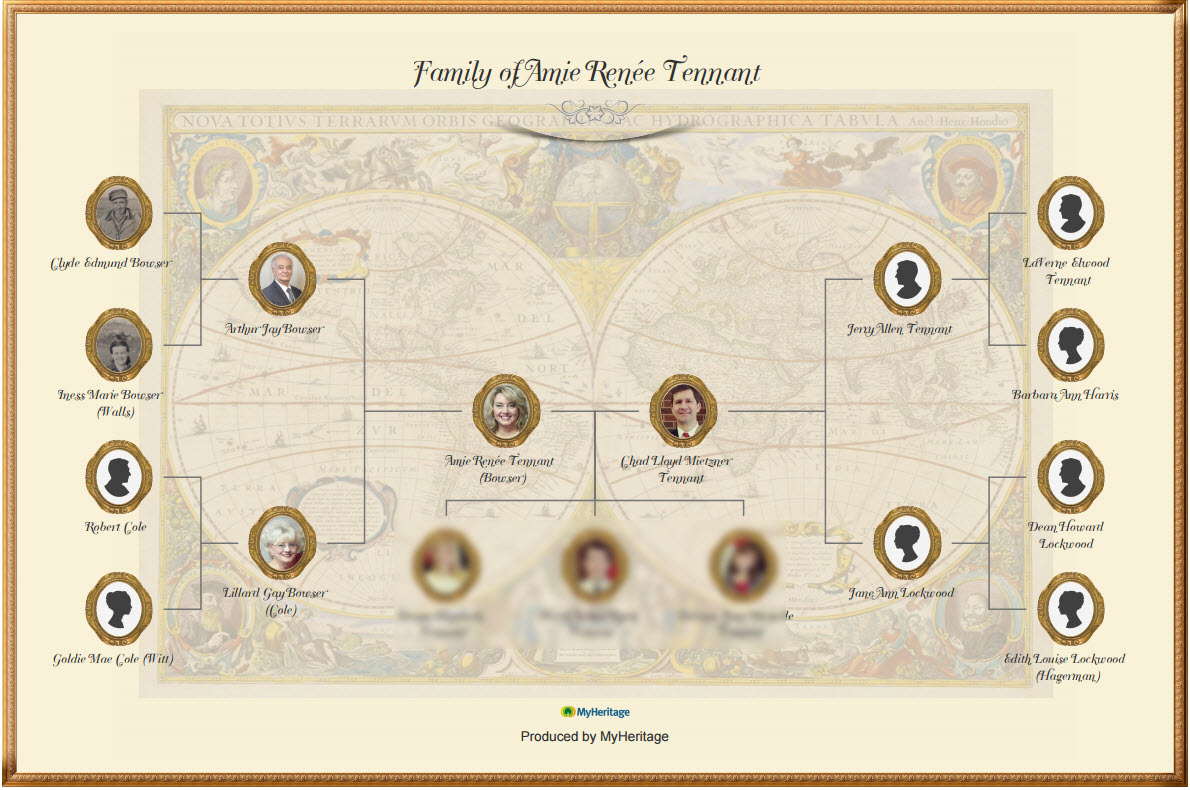
Bowtie Chart by MyHeritage
MyHeritage offers some free access and some things that require a subscription. Creating a free account allows you to create a family tree with 250 people. By upgrading to the PremiumPlus subscription level for $9.95, you are unlimited in the number of people in your family tree. To read more about the pricing and subscription level differences and access our digital MyHeritage Cheat Sheet, click here.
Recently, MyHeritage added a beautiful Sun Chart option. Like in all cases, you must first upload a GEDCOM or create a family tree file. A Sun Chart is a type of descendant fan chart, however, unlike other’s it supports photos. The main person or couple is displayed in the center and the descendants are shown in the outer rings.
To create your own Sun Chart, click Family Tree at the top and choose Print charts & books from the pull-down menu. At the new screen, choose whichever chart you are interested in printing. In this case, I chose the Sun Chart.
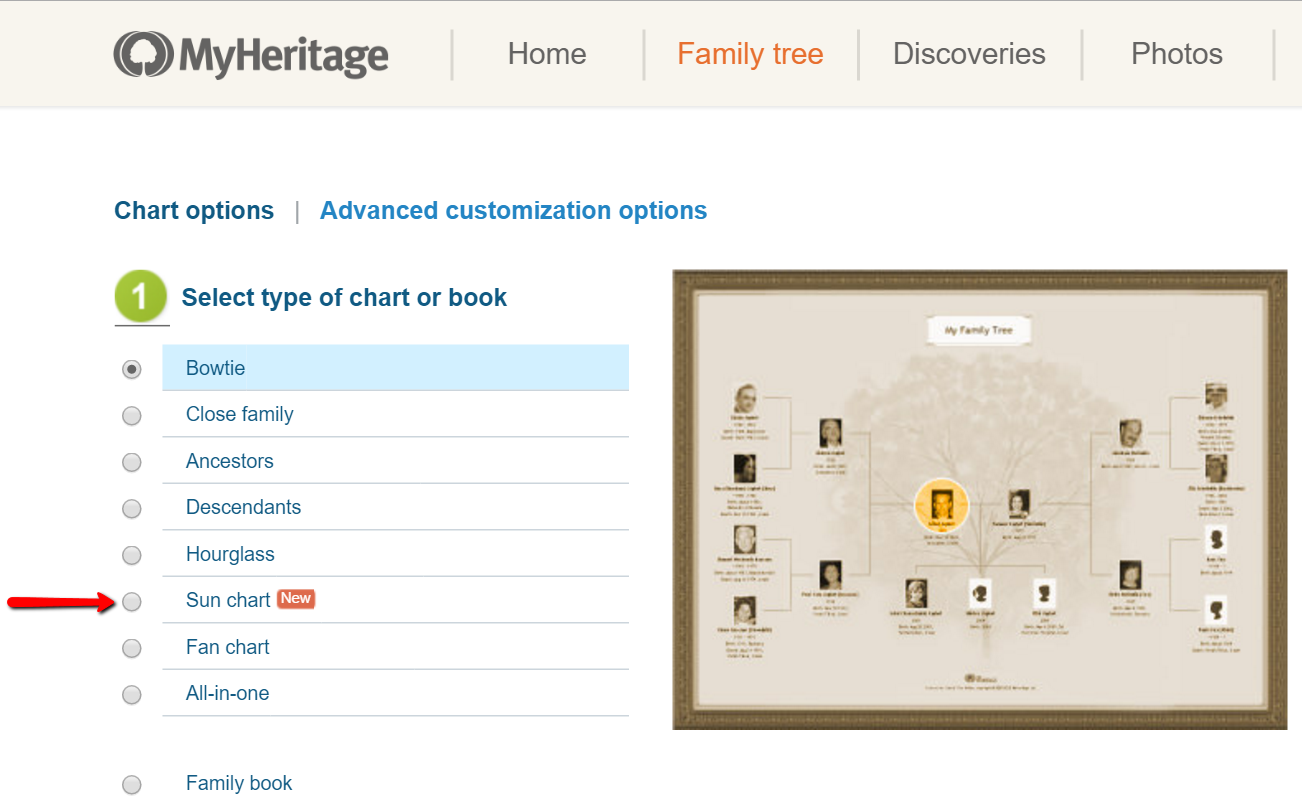
By scrolling down, you can customize your Sun Chart with a title, specific facts for each individual, photo size, and number of generations.
I customized my settings to large pictures size and included only three generations.
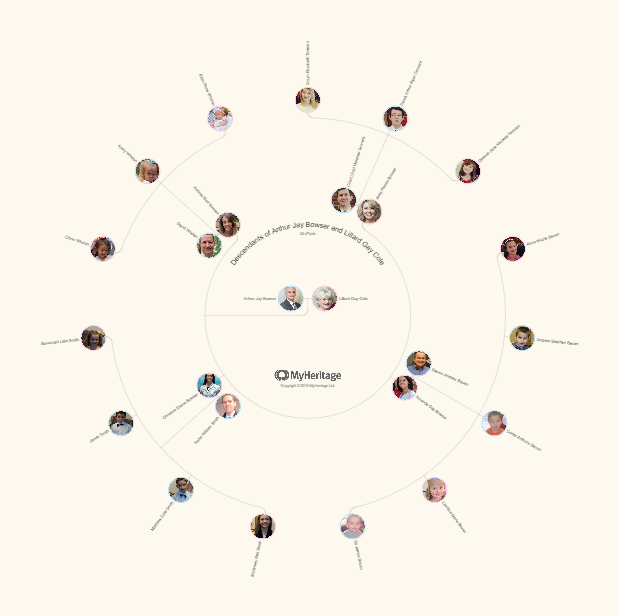
Sun Chart by MyHeritage
It may take several minutes for your chart to be generated. I had to wait about twenty minutues. MyHeritage also allows you to download, print, and even order a poster size of your chart directly from their website.
Create a Family Chart Today!
Whether you decide to share your family tree chart creation via email or printed poster, it will be sure to be a big hit. We would love to hear about your own favorite family tree chart creations and how you have shared them. Please let us know about them in the comments below.
More Gems on Family Tree Charts
Family Tree Builder for Mac Users
Alternate Family Trees Offer Unique Perspective to Family History
3 Ways to Talk About DNA at Your Next Family Reunion
by Lisa Cooke | Jul 3, 2015 | 01 What's New, Australian, British, Canadian, Census, Digital Archives, FamilySearch, Findmypast, images, Immigration, Memory Lane, Military, Photographs, Records & databases, United States

Every Friday, we blog about new genealogy records online. Do any of the collections below relate to your family history? Look below for early Australian settlers, Canadian military and vital records, the 1925 Iowa State Census and a fascinating collection of old New York City photographs.
AUSTRALIAN CONVICT RECORDS. Now Findmypast subscribers can access several collections on early settlers. Among them over 188,000 Australia Convict ships 1786-1849 records, which date to “the ships of First Fleet and include the details of some of the earliest convict settlers in New South Wales.” You’ll also find “nearly 27,000 records, the Australia Convict Conditional and Absolute Pardons 1791-1867 list the details of convicts pardoned by the governor of New South Wales and date back to the earliest days of the colony” and New South Wales Registers of Convicts’ Applications to Marry 1825-1851, with over 26,000 records.
CANADIAN WWI MILITARY RECORDS. As of June 15, 162,570 of 640,000 files are available online via the Soldiers of the First World War: 1914–1918 database on the Library and Archives Canada website. This is the first installment of an ongoing effort to digitize and place online records of the Canadian Expeditionary Force service files.
IOWA STATE CENSUS. About 5.5 million newly-added records from the 1925 state census of Iowa are now free to search at FamilySearch,org. Name, residence, gender, age and marital status are indexed. The linked images may also reveal parents’ birthplaces, owners of a home or farm and name of head of household.
NEW YORK CITY PHOTOGRAPHS. About 16,000 photos of old New York City from the New York Historical Society are free to view on Digital Culture of Metropolitan New York. According to the site, “The extensive photograph collections at the New-York Historical Society are particularly strong in portraits and documentary images of New York-area buildings and street scenes from 1839 to 1945, although contemporary photography continues to be collected.”
ONTARIO, CANADA VITAL RECORDS. Nearly a half million birth record images (1869-1912), nearly a million death record images (1939-1947) and over a million marriage record images (1869-1927) have been added to online, indexed collections at FamilySearch.
 Today’s list of new records has a LOT of Canadian material! If you’re researching Canadian roots, here’s a FREE video for you to watch on our YouTube channel: Lisa Louise Cooke’s interview with Canadian research expert Dave Obee, who shares 10 tips in his effort to help one RootsTech attendee break through her brick wall. This post and tip and brought to you by The Genealogist’s Google Toolbox by Lisa Louise Cooke, newly-revised and completely updated for 2015 with everything you need to find your ancestors with Google’s powerful, free online tools.
Today’s list of new records has a LOT of Canadian material! If you’re researching Canadian roots, here’s a FREE video for you to watch on our YouTube channel: Lisa Louise Cooke’s interview with Canadian research expert Dave Obee, who shares 10 tips in his effort to help one RootsTech attendee break through her brick wall. This post and tip and brought to you by The Genealogist’s Google Toolbox by Lisa Louise Cooke, newly-revised and completely updated for 2015 with everything you need to find your ancestors with Google’s powerful, free online tools.


 Each week we round up the new and updated genealogy records collections for you in a helpful article so you can jump right into researching! Our free weekly email newsletter always has the latest records round up article, as well as other featured articles on genealogy methodology, inspiration, tips and tricks, and more. Plus the newsletter also lets you know where there is a new episode of The Genealogy Gems Podcast, new videos, and updates on news and events. And best of all it’s free! Sign up today to get our email newsletter once a week in your inbox.
Each week we round up the new and updated genealogy records collections for you in a helpful article so you can jump right into researching! Our free weekly email newsletter always has the latest records round up article, as well as other featured articles on genealogy methodology, inspiration, tips and tricks, and more. Plus the newsletter also lets you know where there is a new episode of The Genealogy Gems Podcast, new videos, and updates on news and events. And best of all it’s free! Sign up today to get our email newsletter once a week in your inbox.








